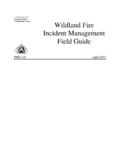Transcription of Developing a Fire Service Training Program
1 Developing a fire Service Training ProgramBY BRADLEY M. PINSKYC ontinuing Education CourseTo earn continuing education credits, you must successfully complete the course examination. The cost for this CE exam is $ For group rates, call (973) THE fire Service FOR 136 BRADLEY M. PINSKYIF we were To be honeST, many oF uS woulD admit that our Training programs do not reach their poten-tial. Sadly, some Training programs are simply ineffective. The existence of a substandard Training Program increases the likelihood of firefighter injuries and decreases the opportunities to perform skills properly, efficiently, and safely. Issues com-mon to many of our Training programs include the following: The Training Program , if one exists at all, fails to provide firefighters with the skills and knowledge to handle the department s operational functions.
2 The required number of Training hours for interior fire -fighters frequently is fewer than 30 hours per year. There is no Training officer; or, if there is a Training officer, the Training officer is not qualified to develop, present, or teach the Program . Department policies are insufficient to guide the develop-ment of Training programs. The individual Training programs do not follow a written lesson plan. The Training Program does not require basic skills to be practiced enough to ensure competence. Advanced skills are not developed. Minimum standards for the performance of skills have not been developed or implemented. The skills of each firefighter are not evaluated on a regu-lar basis. As a result of the above, few persons attend or participate in the many might think that these issues are limited to vol-unteer departments, this is not the case.
3 Career departments face many of the same Training challenges as volunteer departments. Author s note: Do not become overwhelmed while reading this article and become dissuaded by the significant amount of work ahead of you. Developing a Training Program in-volves many steps, and it could take several years to build an adequate Training Program . Smaller departments may want to consider consolidating Training functions with surrounding jurisdictions to provide a broader support network for an ef-ficient and comprehensive Training TO STARTThe first step in Developing a Training Program is to gather the right team. at a minimum, the team should include the chief, the Training officer (To), and the health and safety officer (hSo).
4 Other members of the Training team could include municipal fire instructors, line officers, experienced firefighters, and retired the Organizational StatementThe team should then look to the fire department s organiza-tional statement. occupational Safety and health administration (OSHA) regulations require1 and national fire Protection associa-tion 1500, Standard on fire Department Occupational Safety and Health Program , suggests that the fire department adopt an organizational statement. look at this statement as the strategic focus for your department. The statement guides the To in how to develop the Training Program . although there are several com-ponents to the organizational statement, the To should focus on (1) the services the department will provide and (2) the types of Training the department will offer and permit firefighters to take within and outside of the department not confuse the organizational statement with the mis-sion statement.
5 The organizational statement is more specific and covers the services provided. an example follows: The services that the department will provide to the public are as follows, with levels stated as appropriate: interior firefighting scene support rehabilitation auto extrication wilderness firefighting ice rescue rope rescue to the technical level transporting emergency medical services to the advanced life support level fire police/traffic control wilderness search and rescue hazardous materials to the operations level confined space to the awareness level. Educational ObjectivesOn completion of this course, students will1. Determine if your Training programs reach their potential2. How to consult your Organizational Statement when Developing a Training program3.
6 Learn how to prepare lesson plans4. Discover legal requirements for trainingDeveloping a fire Service Training Program portion of the statement is important. It provides the To with clear instructions on the general services firefighters must perform. The To must ensure that personnel are capable of delivering these services in a safe and an efficient , when Developing the Program , the To should ensure the following: Each Service offered by the department receives adequate attention in the Training Program . Each firefighter is expected to provide the services in which they participate in the Training programs. Each firefighter is capable of performing the skills to a set another way, if the fire department provides a Service to the public, the TO must provide adequate Training to the department members in that To is not the only official guided by the organizational statement.
7 This list arms the chief with solid reasoning and sup-port for the department s budget. To perform the services listed in the statement, the department must be properly funded with a budget that provides the tools and equipment necessary to deliv-er each of these services . no services should be delivered to the public without adequate equipment or skills. Thus, chiefs who face budget cuts can explain to the municipality that insufficient funding will lead to the elimination of certain services because of a lack of funding for Training or equipment. The municipal-ity may then be asked which services should be eliminated to address such budget cuts. when the inevitable need for such ser-vice arises, the municipality will have placed the department in the unfortunate position of not being able to provide the the Risk management PlanThe hSo must also reference the organizational statement as a first step in performing the job as it relates to the orga-nizational statement and Training Program .
8 NFPA 1500 refers to this as the risk management plan, another document fire departments commonly overlook. The hSo is tasked with Developing the risk management plan. Development of the plan necessitates that the hSo evaluate and rate the risks to firefighters posed by the perfor-mance of each task necessary to provide each Service the de-partment offers. once this evaluation has been completed, the HSO and the TO must ensure that adequate Training is offered to educate firefighters about the risks of performing each task and how to limit the risks . Table 1 illustrates how an evalua-tion of the risks of interior firefighting might look. once this plan is developed, the To and hSo should ensure that adequate Training is provided to each firefighter expected to deliver such services .
9 Give the tasks with the highest risk rating the most attention, although no risk should ever be neglected during Lesson Plans It is not possible to create a short article on how to develop a lesson plan, which is a skill. Just the same, it is crucial that the TO be able to create an adequate lesson plan. This skill is covered in fire instructor Training courses such as fire Instruc-tor I (which instructs students in how to modify a generic lesson plan so that it is applicable for teaching to the specific department or company) and Instructor II (which instructs students in how to create a lesson plan).lesson plans provide objectives for the skills. The objectives should address the risks associated with the Service provided as well as the skills and knowledge needed to provide the Service .
10 Lesson plans should do the following: Indicate the target audience of the Training (interior fire -fighters, operators, for example). Indicate the purpose of the lesson. State under what circumstances the Training will occur. List what the participants will accomplish. Provide the standard used to evaluate participants success. List the materials needed (tools, projectors, props, and so on). Cite a written procedure or policy of the department that underlies the Training . Cite a policy or a chapter to be read by the firefighters prior to the Training class or skills evaluation are some samples of simple objectives: Given a two-story residence and a 24-foot ladder, fire -fighters shall be able to ladder a second-story window to permit firefighters to enter and exit; follow (insert name of textbook, edition, and page).






